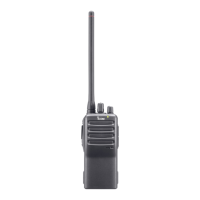21
5
BATTERY CHARGING
R DANGER! NEVER solder the battery terminals or NEVER
modify the battery pack. This may cause heat generation, and the
battery may rupture, emit smoke or catch fire.
R DANGER! Use the battery only with the transceiver for which it
is specified. Never use a battery with any other equipment, or for
any purpose that is not specified in this instruction manual.
R DANGER! If fluid from inside the battery gets in your eyes,
blindness can result. Rinse your eyes with clean water, without
rubbing them, and see a doctor immediately.
WARNING! Immediately stop using the battery if it emits an ab-
normal odor, heats up, or is discolored or deformed. If any of these
conditions occur, contact your Icom dealer or distributor.
WARNING! Immediately wash, using clean water, any part of the
body that comes into contact with fluid from inside the battery.
WARNING! NEVER put the battery in a microwave oven, high-
pressure container, or in an induction heating cooker. This could
cause a fire, overheating, or cause the battery to rupture.
CAUTION! Always use the battery within the specified temperature
range for the transceiver (–25˚C to +55˚C) and the battery itself
(–20˚C to +60˚C). Using the battery out of its specified temperature
range will reduce the battery’s performance and battery life. Please
note that the specified temperature range of the battery may ex
-
ceed that of the transceiver. In such cases, the transceiver may not
work properly because it is out of its operating temperature range.
CAUTION! Shorter battery life could occur if the battery is left fully
charged, completely discharged, or in an excessive temperature
environment (above +50˚C) for an extended period of time. If the
battery must be left unused for a long time, it must be detached
from the radio after discharging. You may use the battery until the
remaining capacity is about half, then keep it safely in a cool dry
place with the temperature between –20˚C to +20˚C.
1
2
3
4
5
6
7
8
9
10
11
12
13
14
15
16
17
18
19
20

